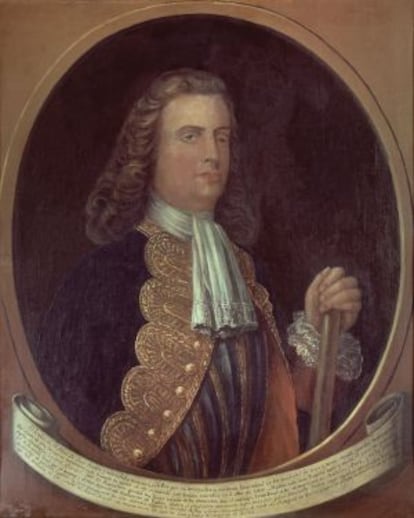One leg, an eye and an arm vs. England
In 1741 Blas de Lezo prevented a massive invasion force from taking Cartagena de Indias

A blessing, bishop, in the name of God I ask it.
Doña Josefa Pacheco was very much aware of what she was demanding. Strength, and a beam of glory from God, for the benefit of her husband - Don Blas de Lezo, that obstinate Basque born at Pasaia in Gipuzkoa, who admitted no weakness in his own life and had scarce patience for it in others. He had to defend Cartagena de Indias, the port that was the linchpin of Spanish power in the Americas. If it fell, the English might do what they pleased throughout South America.
This was in the War of Jenkins' Ear, which began in 1738 when an English captain of that name, on a vessel running contraband goods into Florida (all trade into the colonies being a Spanish monopoly), had his ear cut off by a Spanish coast guard captain. Or so he claimed. The party in England that wanted an aggressive policy, to force the Spanish to permit more trade into their colonies, magnified the incident into a casus belli . Jenkins was presented before parliament, producing his severed ear for the members' contemplation.
Two years later in Cartagena, in March of 1741, the outlook for the Spanish was bad. The attacking English force, some 23,600 men under the command of Admiral Vernon, outnumbered the 6,000 Spaniards in Cartagena by four to one. One of Vernon's captains of marines was Lawrence Washington, an elder half-brother of the future president. Firepower, too, was unequal. The Spanish had 990 cannon, against 3,000 for the English. Only faith, or fanaticism, could save the day.
Jenkins showed parliamentary members his severed ear
The people of Cartagena had little faith in the admiral the king had sent to defend the place, or in the king himself, Philip V. Early in 1741, with the tropical port facing imminent siege, the latest thing that had occurred to the Sun King's eccentric (or lunatic) grandson - who dirtied his bed at night, and spent most of the day in delirium, and had hired the castrato Farinelli to sing him nocturnal lullabies - was to send them a proud mariner who had described his qualifications for the task as being "one-legged, one-handed and one-eyed."
Mediohombre (half-man) was one of the epithets applied to Lezo when the tock-tock of his pegleg was heard approaching. What could this whittled-down figure do against the awesome armada commanded by Vernon?
Well, he could at least face them, and deal with them as best he could. He had already come up against Vernon before, in Gibraltar - that Rock which is still with us, always ready for the Spanish government to raise a media fuss about, to distract public attention from its own sordid embarrassments. Vernon left Gibraltar with 200 guineas in his pocket, and Lezo, minus a leg.
He was only 15 years old, with a hard adolescence of salt water and gunpowder behind him, when a cannonball shattered one of his legs, which had to be amputated below the knee with no anesthetic other than a stiff shot of whisky, and the fainting spell caused by the pain as the saw cut into the bone, and then when the stump was dipped in boiling oil to cauterize it. However, it is recorded of him that he kept silent through the ordeal.
Vernon left Gibraltar with 200 guineas in his pocket, and Lezo, minus a leg
The young Basque rose steadily in rank, even as further pieces were whittled off him. About two years after Gibraltar, while attacking a fort in Toulon, he lost an eye to a flying shard of stone. At the age of 25 he was a captain and back in the Mediterranean, provisioning the ships that were blockading Barcelona in the War of the Spanish Succession. While bombarding the city aboard the Campanella, a musket ball went through his right forearm, leading to another amputation.
Later, on service in the Pacific, he married Josefa Pacheco in Lima. Later still, by the time he showed up in Cartagena to defend the city, he was a living legend to Spanish sailors.
So now Vernon was again his enemy, in a siege that was to become a legend for future generations. Vernon, too, had moved up in rank and was, he thought, about to make a legendary conquest. Cartagena was in fact, the biggest amphibious attack until the Normandy landings two centuries later. Certainly the most famous literary account is in The Adventures of Roderick Random , the picaresque novel by Tobias Smollett, who was a surgeon aboard one of Vernon's ships.
The Spaniard, knowing his troops' inferior numbers, saw he had to find some stratagem. The Englishman was, it appears, overconfident in the massive power of his fleet - which, as the historian Vicente Pascual explains, soon turned into an unwieldy liability. By March the English had decided to storm the fortress. Lezo waited. Some of the measures he took were aimed at concealing his numerical inferiority. Another was a camouflaged ditch that, in the event, rendered the English scaling ladders useless, leaving the troops trapped on an exposed glacis, open to a Spanish counter-attack, which was not long in coming.
Soon the English retreated to their ships and, unable to land, saw no alternative but to wait. They remained in their ships for a month. Yellow fever broke out aboard, killing far more men than had been lost in the assault. Supplies ran out. Many men deserted to the Spanish, offering to convert to the faith of Rome, having heard that in the Spanish hospitals you got a square meal. Finally Vernon decided to raise the siege, and went back to Jamaica, sending Lezo a letter to the effect that he would soon be back with reinforcements. Lezo replied that he doubted this, "because your ships are now good only for carrying coal from Ireland to London."
The end was an anticlimax. Lezo, whose personality seems to have been abrasive, was bitterly resented by the Spanish viceroy of New Granada, Sebastián Eslava, a court gentleman who was quite useless as a soldier. The latter took every opportunity of obstructing Lezo, and soon managed to compass his fall from grace with the king in Madrid. Then the yellow fever carried Lezo away on September 7, 1741, leaving his family in straitened circumstances. However, some years later, on his accession to the throne, Charles III ennobled his eldest son.
Vernon, watching the walls of Cartagena sink below the horizon, is said to have yelled to the wind, "God damn you, Lezo!" Glorious conquest of the Americas had eluded him, but a comfortable and honored retirement lay ahead in England. He wrote on naval matters, and was responsible for many improvements in naval routine. One of these was watering the sailors' drink (instead of giving them straight rum), for which he is remembered as "Old Grog." Vernon's epitaph, on his monument in Westminster Abbey, reads: "He subdued Chagres, and at Carthagena conquered as far as naval forces could carry victory."
Tu suscripción se está usando en otro dispositivo
¿Quieres añadir otro usuario a tu suscripción?
Si continúas leyendo en este dispositivo, no se podrá leer en el otro.
FlechaTu suscripción se está usando en otro dispositivo y solo puedes acceder a EL PAÍS desde un dispositivo a la vez.
Si quieres compartir tu cuenta, cambia tu suscripción a la modalidad Premium, así podrás añadir otro usuario. Cada uno accederá con su propia cuenta de email, lo que os permitirá personalizar vuestra experiencia en EL PAÍS.
¿Tienes una suscripción de empresa? Accede aquí para contratar más cuentas.
En el caso de no saber quién está usando tu cuenta, te recomendamos cambiar tu contraseña aquí.
Si decides continuar compartiendo tu cuenta, este mensaje se mostrará en tu dispositivo y en el de la otra persona que está usando tu cuenta de forma indefinida, afectando a tu experiencia de lectura. Puedes consultar aquí los términos y condiciones de la suscripción digital.
Últimas noticias
Maduro pleads not guilty before the federal court in New York: ‘I am still the president of Venezuela’
A new test can detect Alzheimer’s from a finger prick
UN team enters Sudanese city of El Fasher after paramilitary massacre: ‘It’s like a ghost town’
A recipe for resistance: Indigenous peoples politicize their struggles from the kitchen
Most viewed
- Gilles Lipovetsky: ‘If you want to live better and fall in love, take Prozac, don’t look to philosophy’
- Alain Aspect, Nobel laureate in physics: ‘Einstein was so smart that he would have had to recognize quantum entanglement’
- Alvin Hellerstein, a 92-year-old judge appointed by Bill Clinton, to preside over Maduro’s trial in New York
- Maduro’s downfall puts China’s relationship with Venezuela to the test
- Why oil has been at the center of Venezuela-US conflicts for decades









































